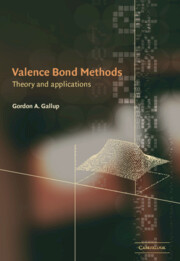Book contents
- Frontmatter
- Contents
- Preface
- List of abbreviations
- I Theory and two-electron systems
- II Examples and interpretations
- 9 Selection of structures and arrangement of bases
- 10 Four simple three-electron systems
- 11 Second row homonuclear diatomics
- 12 Second row heteronuclear diatomics
- 13 Methane, ethane and hybridization
- 14 Rings of hydrogen atoms
- 15 Aromatic compounds
- 16 Interaction of molecular fragments
- References
- Index
14 - Rings of hydrogen atoms
Published online by Cambridge University Press: 13 August 2009
- Frontmatter
- Contents
- Preface
- List of abbreviations
- I Theory and two-electron systems
- II Examples and interpretations
- 9 Selection of structures and arrangement of bases
- 10 Four simple three-electron systems
- 11 Second row homonuclear diatomics
- 12 Second row heteronuclear diatomics
- 13 Methane, ethane and hybridization
- 14 Rings of hydrogen atoms
- 15 Aromatic compounds
- 16 Interaction of molecular fragments
- References
- Index
Summary
In this chapter we examine some results for four model systems consisting of rings of H atoms. These calculations show how the number of atoms in a complex reaction may influence rates of reaction, particularly through the activation energy. The systems are as follows.
Four H atoms in a rectangular geometry of D2h symmetry. The rectangle is characterized by two distances, RA and RB. We map out a region of the ground state energy for this four-electron system as a function of the two distances.
Six H atoms in a hexagonal geometry of D3h symmetry. This is not a regular hexagon, in general, but, like the system of four H atoms, is characterized by two distances we also label RA and RB. These two distances alternate around the ring. We also calculate the map of the ground state energy for this six-electron system.
Eight H atoms in an octagonal geometry of D4h symmetry and the specific shape characterized by the RA and RB variables as above. For this larger system we only determine the saddle point with respect to the same sort of variables.
Ten H atoms in a decagonal geometry of D5h symmetry and the RA and RB variables. Again, we determine only the saddle point.
Since the geometries of these systems are in most regions not regular polygons, we will symbolize them as (H2)n, emphasizing the number of H2 molecules rather than the total number of atoms.
- Type
- Chapter
- Information
- Valence Bond MethodsTheory and Applications, pp. 191 - 196Publisher: Cambridge University PressPrint publication year: 2002



